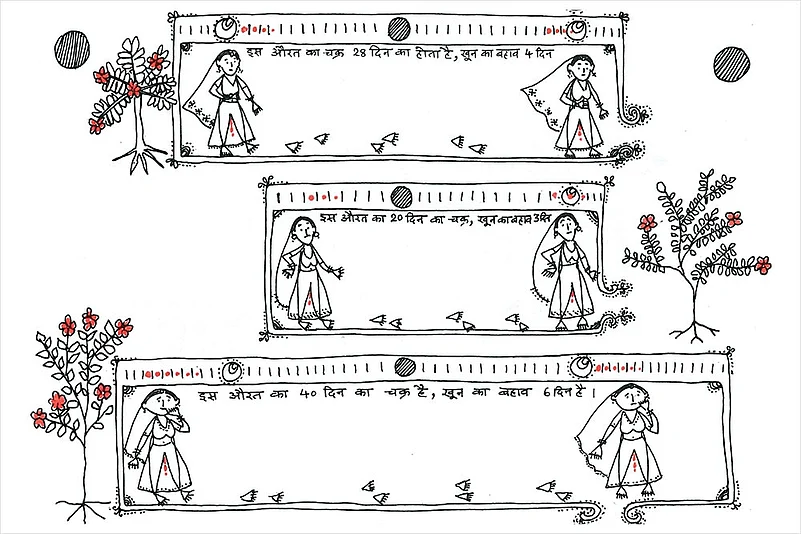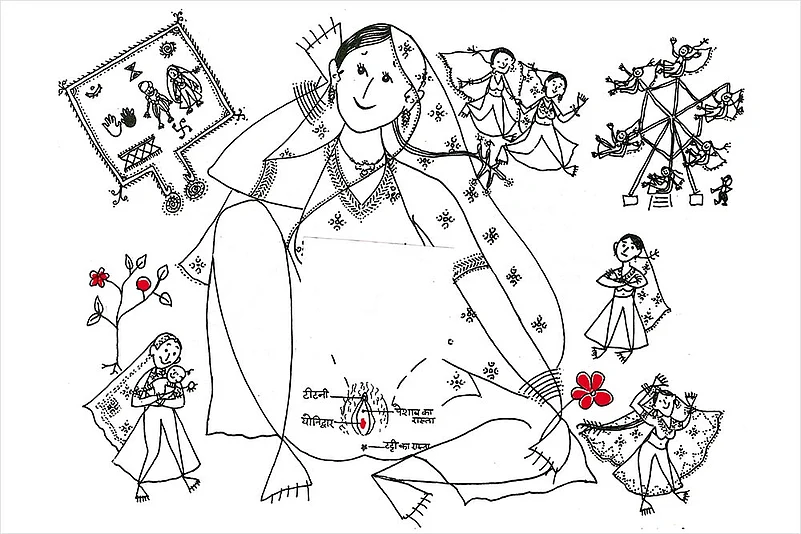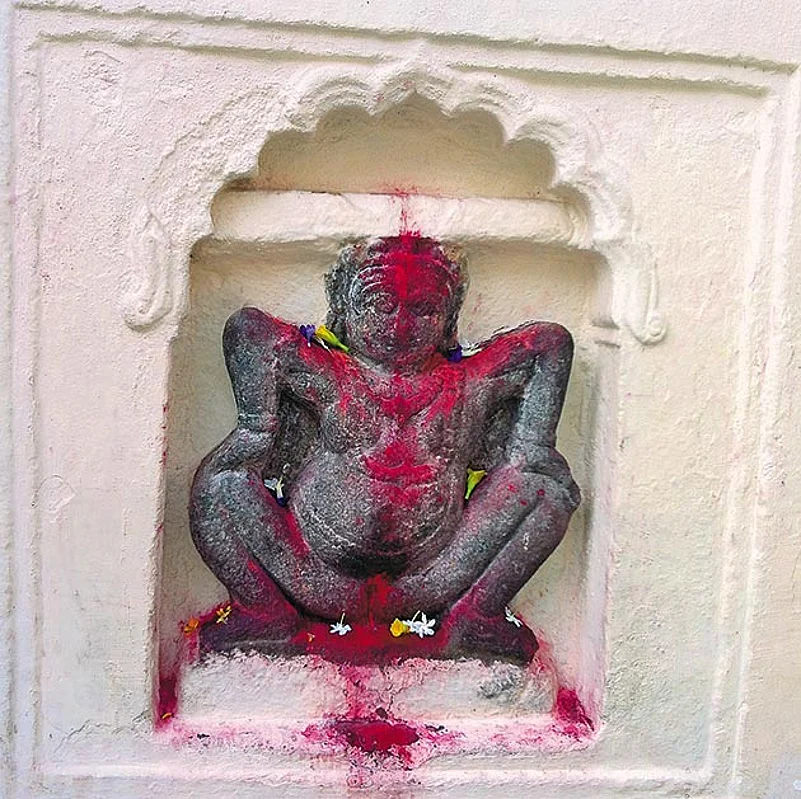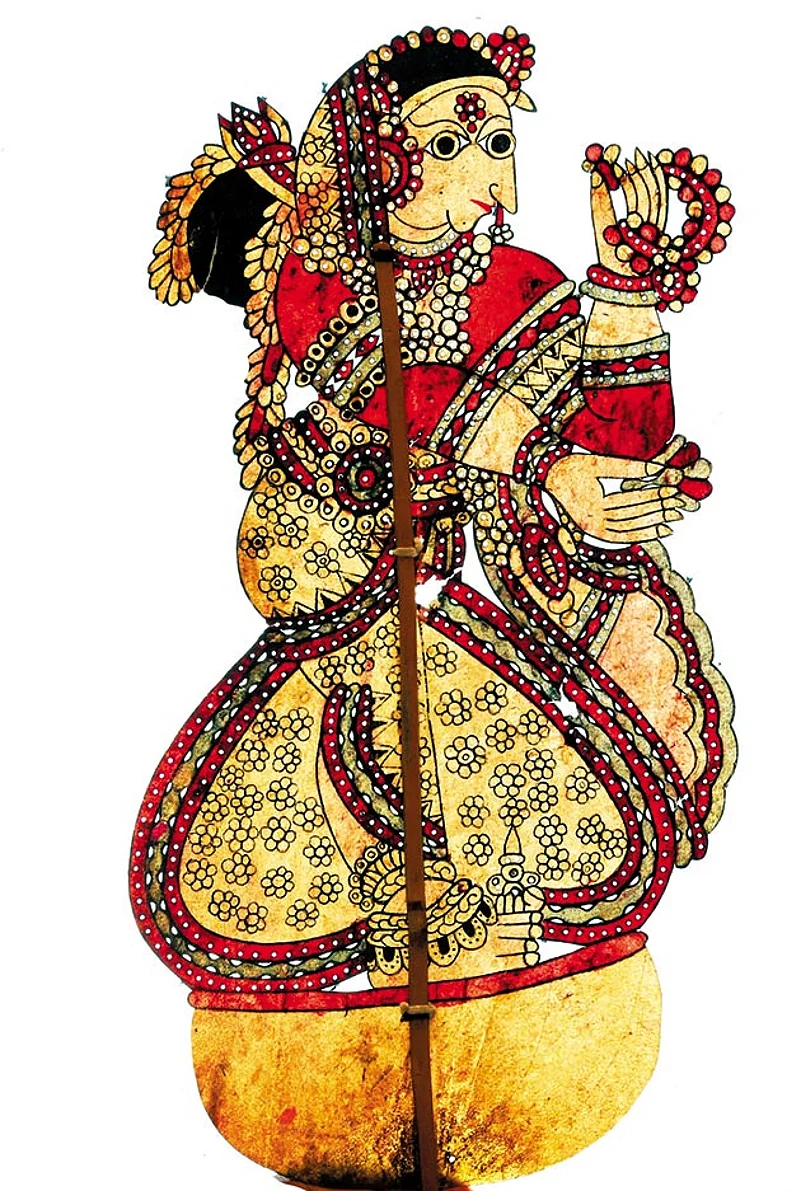The earth itself menstruates. So does the goddess…. Pause on those images, let them sink in. It doesn’t -always take a revolution—a cognitive one or a bloody one—to slip out of a way of seeing, and into another one. Sometimes it’s a mere question of recovering what was there, of excavating our own subsoil. The earth menstruating? You find the idea in age-old, once-a-year festivals in eastern India to mark the onset of the sowing season, or to invoke rain. It connects, as metaphor and as a cue for practical living, the circadian rhythms of the worklife of early agrarian communities, the mensual rhythms of the body and the annual cyclical arrival of the seasons. A metaphorical web that gives us something even contemporary global cultures are struggling to attain: a cleanly positive valuation of menstruation, one that unfussily links it to fertility, to life and its rhythms, to sustenance.
When The Folk Arts Spoke Menstruation
From Baul songs to Lavani, to old rites of passage, red is positive and life-affirming

There’s no trace of stigma in these cultures of holism that link human biology to nature. That’s why women once felt no shame while dancing naked around trees, often in erotic postures, for Hudum—an annual rain-inv-oking event one finds in an ethnic span between the Koch-Rajbongshi belt in north Bengal to Dhubri in Assam. The Raja Parba in Odisha, similarly, was about the earth being ready for sowing. (‘Raja’, pronounced ‘rOjo’, derives from the Sanskrit ‘rajaswala’ for menstruation). Ironically, it’s the overlaying of mainstream cultures and modernity, trapped in its nature/culture divide, that brought on the shame. So the allusions to earth’s menstruation now have to be teased out from the old Raja songs. The people have been largely wrenched away from ‘animism’.

That last word, filtered through layers of modernist bias, greatly diminishes folk and adivasi cultures that saw everything as animated with a life-force, where the world is not a ‘detached mechanical object’. The world isn’t exactly alien to a display of blood, whether in war or just by a minor scrape…but just try ascribing a positive buzz to the English word ‘bleed’ (despite ‘sanguine’ coming from the Latin for ‘blood’). It’s impossible. As a metaphor, the colour red itself raises a flag. And so, perhaps one of the most natural reasons for bloodshed in the world—where women are shedding some of it every single month for a large part of their lives—is swaddled in shame and stigma. Menstruation has warranted anything between panicked moral policing to complete denial of its existence. Or mass urban anger, as in Sabarimala. Through the colourful history of, new-age, “pop” cultures across the world, a menstruating woman and her blood have been cameo artistes at best, and blue at worst.
The contrast with folk cultures, whose fertility goddesses birthed our religions, is stark. ‘Folk culture’, of course, is an idea easy to essentialise as an exotic, immutable artefact of a silly past. A dance there, a daub of colour here, a curiosity to liven up an exhibition pavilion. But these are real, rational people who can still tap into a refreshingly clear-headed way of looking at things, even while drowned in suffocating patriarchy.

In 1987, Deorala in Rajasthan’s Sikar district hit the national headlines with Roop Kanwar and a horrific return to the world of sati. But exactly at the same time, the seeds of a quieter revolution were being sown in the villages of nearby Ajmer, in the same state. Scores of village women were dipping into simple folk motifs to make sketches that had the most astonishingly frank and rational treatment of menstruation and allied themes, culminating in the educational book Shareer Ki Jaankaari (Knowing your Body). “The women actually came to us with their book. Over 70-75 village women from around Bhateri had made all the art,” says Urvashi Butalia, co-founder of Kali for Women, which brought out the Hindi version in 1989. Translations to English and several Indian languages followed, though it’s now out of print (the visuals on these pages are from the sole surviving Hindi copy).
Like societies, the State too can be schizoid: here, it was both progressive and authoritarian. The book was born out of a series of workshops conducted as part of a government initiative. “We were asked to talk about IUD (intrauterine device) as a form of birth control, which is a personal choice, as opposed to top-down population control. Hundreds of drawings came in through those workshops, where women had drawn on chart papers,” says Malika Virdi, who was part of the three-women team heading the workshops. But the programme finally got stalled due to forced sterilisation and the inevitable backlash. “It’s when the crisis peaked that we approached Kali for Women. A lot of people in the villages were initially upset and called the book ‘behuda’ (vulgar),” Virdi recalls. But the final design, meticulously crafted with Virdi’s help, was meant to create “aesthetics that don’t overtly offend”. So the book hides allegedly “pornographic” anatomical diagrams and the menstrual cycle under paper flaps that double up as clothing for the pleasantly drawn stick figures. “The book is equally about sexuality and knowing your body. We were supposed to follow it up with Jaapa ki Jaankaari (Things to Know about Pregnancy), but that too was called off,” Virdi rues.

The tendency to censorship pervades even private spaces, so menstruation is spoken of only in uncomfortable whispers and euphemisms even in homes. Any public hint of it naturally brings on an equation with pornography. But again and again, one finds the folk idiom capable of transcending that. In Lavani, a popular Maharashtrian genre where women perform to songs talking about their everyday lives, menstruation is far from being a taboo. “Still, we never perform these specific songs anywhere other than private baithaks,” says Shakuntala Bai Nagarkar, a 60-year-old Pune-based Lavani dancer. Nagarkar was nurtured in an Ahmednagar family of female Lavani performers: it’s a way of life for her. “Lavani is very erotic in nat-ure. These songs have been performed for generations but we know they would never get the state censor board’s approval,” she says.
“Shivu naka durun majsee bola/ Majha shalu nirieet laal zhala” goes one song, where the woman asks men to not touch her or come close to her as her sari is stained red with period blood. Another asks people to not step into her house for those few days—“Zhale durshee/ Sakhya mala shivu naka/ Don-chaar divasha mahali yeuu naka”. Anticipating rejection from the state’s theatre and performance censor board (set up in 1954), the community of Lavani performers chose not to take the risk in the first place. “It was also to maintain the sanctity and the nature of intimate understanding of such sensitive subjects…. A kind of self-censorship was exercised, those songs were never performed in front of large audiences,” says Lavani scholar Bhushan Korgaonkar.

Lavani artiste Shakuntala Bai dwells on the topic at a private show in Mumbai
The thumb rule to ridding menstruation of its layers of stigma would be to simply recognise it for what it is—a physiological process as natural as breathing or blinking. And doing that comes naturally to ‘native’ philosophies. “It’s the reason the world exists, how is it even possible to turn it into a taboo?” asks Parvathy Baul, an exponent of a tradition of minstrelsy that sprung from the hinterlands of old Bengal. A heterogeneous community of mystics, the Baul-Fakirs are music worshippers from the Vaishnavite and Sufi streams, with antecedents in Tantrism. Parvathy, almost reflexively, starts humming a song in her lilting, rapturous voice, “Shey phool phote baaro bochhor pore/ Maashe maashe ekbaar jhore” (“It takes twelve years for the flower to sprout/ Then the plant sheds its blossoms once a month”)—verses that beautifully capture the essence of menstruation by relating it to the life of a flower. The artiste, who became the first female Baul to be conferred with the Sangeet Natak Akademi award earlier this year, refuses to call her art ‘folk’. “It’s a spiritual tradition. Our gurus have told us that in order to rid ourselves of shame, fear and disgust, we need to first know our bodies well. So there are a lot of Baul songs that metaphorically refer to the menstruation process,” she says before breaking into one more, spontaneously. “Meyer maashe maashe ashe juwaar/ Tribeni shongoti / Mey Ganga Jamuna Saraswati/ Mey jokhon hoy utola/ Teen deen boy leelakhela/ Ek din kaala, ek din shada, ek din laalmoti/ Shei nodi te snaan korile, hobe tomaar gouranga muroti” (“Every month a woman has her ‘high tide’/ As you witness in the conjoined three/ Daughters Ganga, Yamuna, Saraswati/ When a woman bursts in excitement/ The river flows with contentment/ One day she’s black, the next she’s white, she then flows as pearls reddened / If you take a dip in this gushing river/ You become the one that’s golden”). The words are rather telling, as they almost blatantly refer to a woman’s pent-up sexual energies peaking during her periods every month.
The art and ritual culture emerging from the nooks and crevices of India helps map the nation’s alternative voices on this hot-button issue. While one end of the spectrum sees angry, modernised rejection at Sabarimala, the other celebrates a fierce, menstruating goddess. The sheer ubiquity of Bhagavathy/Mariamman temples in the South gives notice to an underlying Shaktism, a legacy of old fertility goddesses, a branch of Hinduism where this is a recurrent metaphor. The most striking example: the temple of Kamakhya on the outskirts of Guwahati—one of the 108 peeths where Goddess Shakti’s severed body parts fell, as per myth. The temple venerates the goddess’s yoni or genitalia. Legend has it that a curse-ridden Kamadeva, the god of eros, sought out Shakti’s womb to regain his virility, which he did. As a yearly celebration of the bleeding goddess, the four-day-long Ambubachi Mela, hosted across Assam and Bengal in June, marks Shakti’s menstrual cycle. Odisha’s Raja Parba falls in the same month. “Till today, young girls can be seen on swings during Raja, mostly in the interiors,” says Rita Ray, former professor of sociology at Utkal University. “They’re pampered with new clothes, shoes and fed sweetmeat for those three days.”

Old Raja parables are laden with metaphors of female sexuality and verses that allude to her attaining puberty, according to the sociologist. “Rasiru chadila chopa...Doli ta laguchi eka eka lo, kaha bina eka eka...Bana podigale duniya jaane lo, mana katha kiye jaane?” (“The skin peels off the sesame...But now the swing looks empty and deserted...Everyone knows when the forest catches fire, but who knows when my heart is burning?”) The skin peeling off the sesame is an obvious allusion to menarche, the first time the thick uterus lining is shed for menstruation. “But now people refuse to talk about it or even associate such a popular song to menstruation or sexuality,” says Ray. Swinging itself, she says, is symbolic of an “act of sexual pleasure”: the second verse implies a woman becoming ready for a “partner”.
Back in Assam, Kamakhya isn’t the only one whose menstrual celebrations you might witness . “Tuloni Biya is celebrated when a girl att-ains menarche, now mostly restricted to the poorer castes and the rural parts. The caste elite look down upon it as an ‘advertisement’ of their daughters becoming ‘eligible for marriage’. But for tribals and other castes, it’s a celebration and nothing to be ashamed of,” says Prof Shashwati Goswami of IIMC, Delhi. “Horina dehkile najaba khedi/ Puruxor kaxoloi najaba saapi/ Puruxe najane naarir mul/ Naari je epaahi dhuniya phul” (“Don’t go running after a deer/ Don’t go near men/ Men don’t know the worth of women/ That women are beautiful flowers”), goes a song sung during the week-long carnival. This biya, or marriage, is nothing but a proxy wedding of a young girl (now capable of bearing a child) to a banana sapling, an old symbol of fertility. The verses clearly allude to Sita chasing a golden deer, a metaphor for the pursuit of an elusive happiness, embodied in men. An ironic bivalence is contained here: a celebration of the true nature of women, but also its eventual embedment in patriarchal cultures and the still-prevalent practice of child marriage.
One could perhaps still take a chance, though, and believe that art mostly emancipates. Gunduraju, a veteran leather puppeteer from Hassan, has travelled across Karnataka educating villagers about menstruation.
“Nearly ten years back, the state government asked me to educate the Gopala (cattle-rearing) community through my puppet shows. I’ve travelled to some 80-100 villages, talking to people about menstruation using tales from the Mahabharata and Ramayana,” says the practitioner of Togalu Gombeyatta (leather puppetry, whose Draupadi puppet is shown here). He received both appreciation and brickbats. “A few women resisted my shows…they said that if I tell the men that women should be allowed to function -normally on their periods, they would lose out on their few days of rest!” the puppeteer laughs.
The sources of possible red-emption seem buried under these same cultures, which now exhibit a tragic top layer of patriarchy. In Tamil Nadu’s recent cyclone, the chilling story of menstrual taboo claiming the life of a 12-year-old made nat-ional headlines. While irony died a slow death knowing the child belonged to the same state as the legendary ‘Padman’, little Vijaya lost her life to a tree crashing down on the thatched roof she was made to live under. Only three days into her puberty, the Thanjavur girl had already been deemed ‘impure’ and unfit to live in her own house.
Unbeknownst to us, many untold stories from the silent interiors of India may still continue to traverse the same old trajectory of blood for blood. So perhaps now, more than ever, it’s time we painted our fields and forests and towns a lasting shade of red.?




















